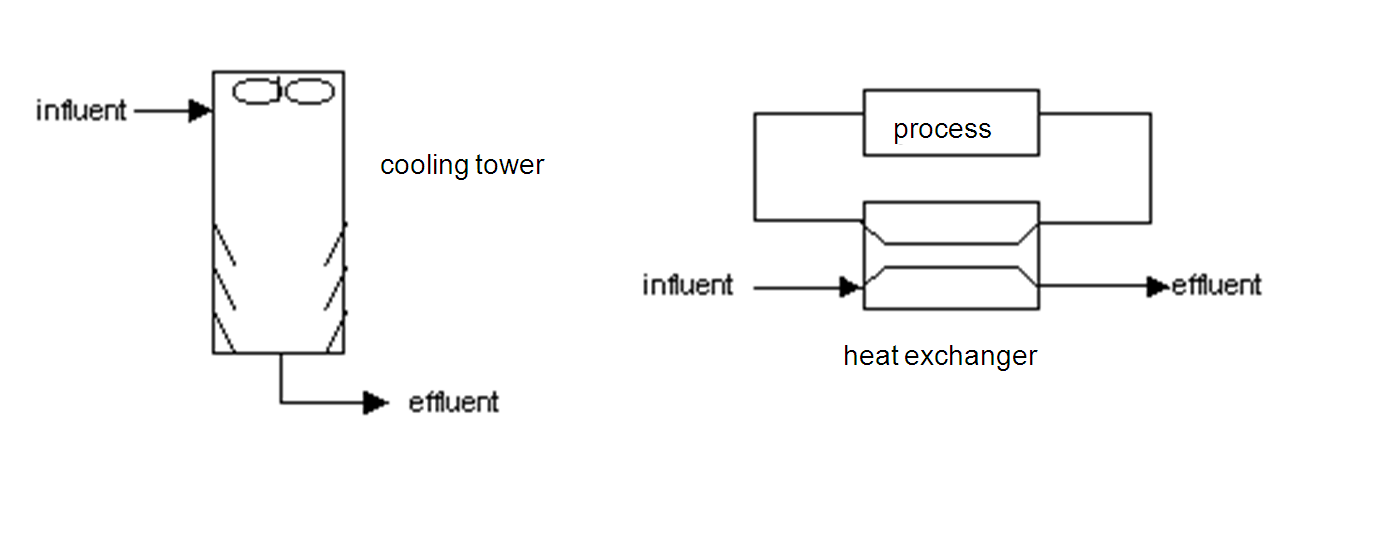Method diagram

Method and installation description
Companies have various ways of cooling operational process flows. In addition to cooling gas (like air or ammoniac), for example, companies primarily use water for cooling processes. Operational processes can be cooled using water in a variety of ways. The main distinction is based on through-flow systems and re-circulation systems. Through-flow systems work with a single heat exchanger (this can also be a cooling tower), where the water will only be used once before it is discharged. In practice, re-circulation systems are becoming ever more popular. They include open and closed systems. Water is not refreshed in completely closed systems. These closed systems are often used for air conditioning systems (re-cooling with air), building management systems, etc. A certain degree of refreshing takes place in open re-circulating systems; this is done to compensate for evaporation losses and to appropriately deal with salt-related issues.
It may also be necessary to cool a particular flow in wastewater systems. This may be necessary if the temperature of the wastewater is too high to implement biological purification. Even if the treated wastewater has a temperature that is too high to be discharged, norms and requirements can still be met by implemented cooling. All the above systems can be implemented, depending on temperature development and/or the dirt load.
Specific advantages and disadvantages
By implementing a cooling process, it is possible to optimise biological purification or to meet discharge norms. In some cases, the heat that is exchanged in a heat exchanger can be put to an effective use. An example of this is the cooling of wastewater from a milk factory using a heat exchanger, which is used again to heat up the water in a swimming pool.
Cooling water systems are likely to deliver a wide range of problems, like corrosion, lime deposits and the formation of micro-biological pollutants. If cooling water is implemented in wastewater purification, these problems will be encountered to a severe degree. Well-known problems include slime-forming in heat exchangers, formation of biomass in a cooling tower package and corrosion caused by iron-reducing bacteria. Many emergency measures are often needed to resolve these problems.
Application
Various purifications in different industrial sectors - like the food, galvanic and chemical sectors - use one or multiple cooling phases.
An example is a vapour-condensate flow from a milk factory; the temperature of such a water flow is too high to pass to the biological purification phase and must first be cooled.
Boundary conditions
Depending on the polluted components, a programme must be compiled to effectively deal with the problems. This can be either chemical, physical or thermal.
Effectiveness
All cooling yields are attainable. The main feature is that energy can be recovered from the system in a useful manner.
Support aids
Lime stabilisers, anti-corrosion products, biocides, dispersion products, etc.
Environmental issues
The use of support aids must be avoided wherever possible, because it may have a negative environmental impact. National guidelines (particularly for the use of biocides) must be adhered to.
Costs
The investment cost can vary greatly depending on the type of cooling system.
Comments
Air cooling is also possible for very large volumes (cooling towers).
Complexity
Simple system, though problems can be complex.
Level of automation
Far-reaching automation.
References
- WASS, 2000
Version February 2010

